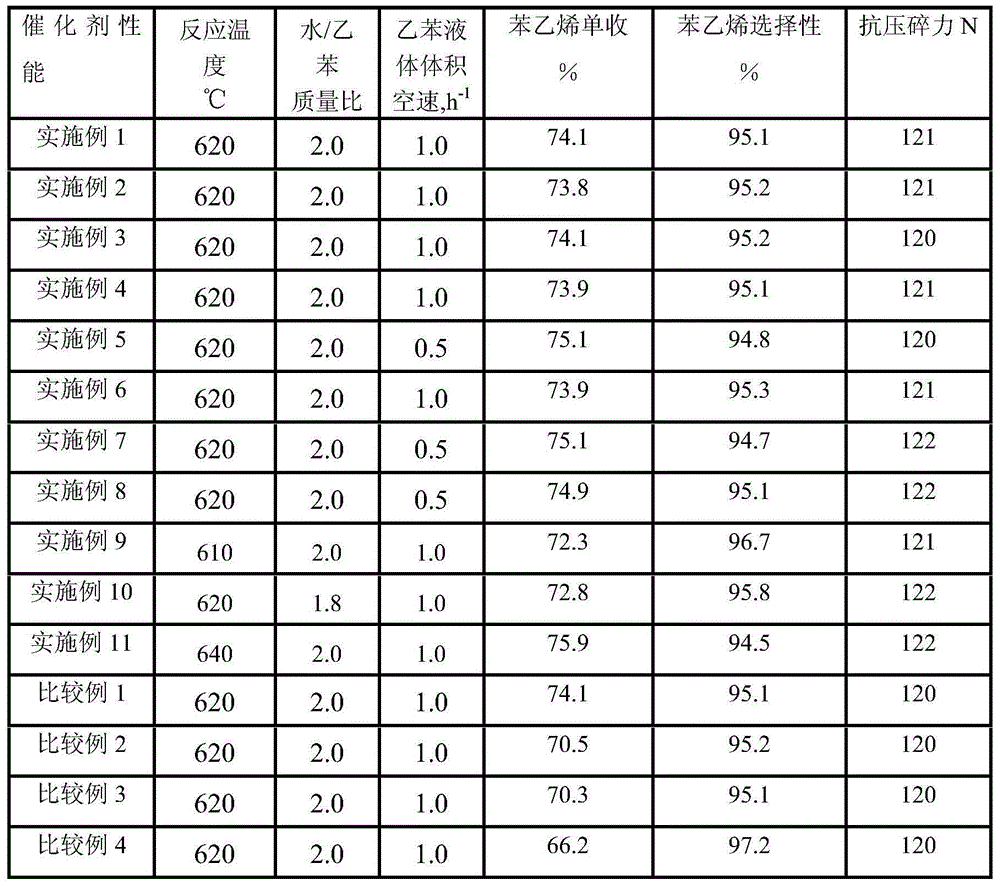Catalyst used for producing styrene via ethylbenzene dehydrogenation
A technology for the dehydrogenation of ethylbenzene and styrene, which is applied in the direction of physical/chemical process catalysts, metal/metal oxide/metal hydroxide catalysts, hydrocarbons, etc., and can solve the problems of reduced catalyst activity and high catalyst production costs
- Summary
- Abstract
- Description
- Claims
- Application Information
AI Technical Summary
Problems solved by technology
Method used
Image
Examples
Embodiment 1
[0036] 1. Catalyst preparation
[0037] Mix 65 parts of red iron oxide, 6 parts of potassium oxide, 2 parts of cerium oxide, 7 parts of magnesium oxide, 0.3 parts of calcium oxide, 0.5 parts of zinc oxide, 2 parts of nickel oxide, and 4 parts of carboxymethyl cellulose, and add 40 Part deionized water, knead the wet material into a dough-like material suitable for extrusion, extrude, cut into pellets, age at room temperature for 10 hours, put in an oven, dry at 80°C for 6 hours, place in a roasting furnace, and bake at 800°C The catalyst finished product was obtained in 2 hours, and for the convenience of comparison, the composition of the catalyst is listed in Table 1.
[0038] 2. Catalyst evaluation
[0039] Load 100ml of catalyst into the evaluation reactor, the reaction pressure is normal pressure, the reaction temperature is 620°C, the mass ratio of water / ethylbenzene is 2.0, and the liquid volume space velocity of ethylbenzene is 1.0h -1 Catalytic activity evaluation w...
Embodiment 2
[0041] 1. Catalyst preparation
[0042] Mix 94 parts of red iron oxide, 9.5 parts of potassium oxide, 3 parts of cerium oxide, 8 parts of magnesium oxide, 7 parts of calcium oxide, 1.2 parts of zinc oxide, 0.2 parts of nickel oxide, and 4 parts of carboxymethyl cellulose, and add 40 Part deionized water, knead the wet material into a dough-like material suitable for extrusion, extrude, cut into pellets, age at room temperature for 10 hours, put in an oven, dry at 80°C for 6 hours, place in a roasting furnace, and bake at 800°C The catalyst finished product was obtained in 2 hours, and for the convenience of comparison, the composition of the catalyst is listed in Table 1.
[0043] 2. Catalyst evaluation
[0044] Load 100ml of catalyst into the evaluation reactor, the reaction pressure is normal pressure, the reaction temperature is 620°C, the mass ratio of water / ethylbenzene is 2.0, and the liquid volume space velocity of ethylbenzene is 1.0h -1 Catalytic activity evaluation...
Embodiment 3
[0046] 1. Catalyst preparation
[0047] Mix 66 parts of red iron oxide, 9 parts of potassium oxide, 5 parts of cerium oxide, 0.8 parts of magnesium oxide, 8 parts of calcium oxide, 0.1 part of zinc oxide, 4 parts of nickel oxide, 4 parts of carboxymethyl cellulose, and add 40 Part deionized water, knead the wet material into a dough-like material suitable for extrusion, extrude, cut into pellets, age at room temperature for 10 hours, put in an oven, dry at 80°C for 6 hours, place in a roasting furnace, and bake at 800°C The catalyst finished product was obtained in 2 hours, and for the convenience of comparison, the composition of the catalyst is listed in Table 1.
[0048] 2. Catalyst evaluation
[0049] Load 100ml of catalyst into the evaluation reactor, the reaction pressure is normal pressure, the reaction temperature is 620°C, the mass ratio of water / ethylbenzene is 2.0, and the liquid volume space velocity of ethylbenzene is 1.0h -1 Catalytic activity evaluation was ca...
PUM
| Property | Measurement | Unit |
|---|---|---|
| length | aaaaa | aaaaa |
| crushing resistance | aaaaa | aaaaa |
| crushing resistance | aaaaa | aaaaa |
Abstract
Description
Claims
Application Information
 Login to View More
Login to View More - Generate Ideas
- Intellectual Property
- Life Sciences
- Materials
- Tech Scout
- Unparalleled Data Quality
- Higher Quality Content
- 60% Fewer Hallucinations
Browse by: Latest US Patents, China's latest patents, Technical Efficacy Thesaurus, Application Domain, Technology Topic, Popular Technical Reports.
© 2025 PatSnap. All rights reserved.Legal|Privacy policy|Modern Slavery Act Transparency Statement|Sitemap|About US| Contact US: help@patsnap.com



